Choosing a starting point to talk about the human evolution timeline is tricky. Do we begin with single-celled organisms, the earliest primates, or the so-called ‘missing link’ between monkeys and humans? The truth is, our evolutionary story is filled with many fascinating steps worth mentioning. After all, it’s the most important story we have to tell.
The human evolution timeline truly begins with the first vertebrates in Earth’s oceans. Over the next 500 million years, these organisms gradually evolved into what we now call Homo sapiens—the most intelligent species on the planet, or so we like to believe. Let’s explore where this journey began and how it shaped modern humans into who we are today.
In this article
Ape to Human Evolution Timeline
Choosing a starting point to talk about the human evolution timeline is tricky. Do we begin with single-celled organisms, the earliest primates, or the so-called ‘missing link’ between monkeys and humans? The truth is, our evolutionary story is filled with many fascinating steps worth mentioning. After all, it’s the most important story we have to tell.
The human evolution timeline truly begins with the first vertebrates in Earth’s oceans. Over the next 500 million years, these organisms gradually evolved into what we now call Homo sapiens—the most intelligent species on the planet, or so we like to believe. Let’s explore where this journey began and how it shaped modern humans into who we are today.
Our species first appeared in Africa about 315,000 years ago, but we weren’t the first of our kind. Fossil evidence reveals that earlier hominins like Ardipithecus and Australopithecus walked the Earth long before us. In fact, we’ve shared this planet with many other primates, from gorillas to now-extinct relatives such as the Neanderthals.
Even though scientists have uncovered many clues about our origins, the exact family tree of human evolution is still being pieced together. And that mystery makes the journey even more fascinating. Until the full story is revealed, here’s what we know about the human evolution timeline so far.
First Vertebrates ( 500+ Million Years Ago)
While we want to believe the world always revolved around us, the story of human evolution actually began deep in the oceans. Around 518 million years ago, during the Cambrian period, the first vertebrate-like animals appeared in the oceans. These were primitive, jawless, fish-like creatures with backbones.
Their backbones set them apart from other creatures, and this feature alone became the foundation of all vertebrate life. From mammals, primates, to finally modern humans. If it weren’t for these early swimmers, the journey of human evolution might never have begun.
Tetrapods Evolve ( 375 Million Years Ago)
Here’s where things turned exciting. Some of the swimmers mentioned earlier made a bold decision to step out of the oceans and onto land. But it wasn’t as simple as it sounds. At first, these fish used their strong, fleshy fins to crawl through shallow waters. Over time, those fins evolved into limbs that could support walking on land. These pioneering creatures became known as tetrapods, meaning ‘four-legged.’
This game-changing leap opened the door for the evolution of mammals, reptiles, amphibians, and even birds. Can you imagine what the world would be like if tetrapods had never thought out of the box, or rather, out of the water? Humans would not exist.
First Amniotes ( 320 Million Years Ago)
The next organisms to evolve were the amniotes, animals that laid the first eggs on land. These eggs had protective shells that allowed their offspring to survive outside of water. Can you imagine something as common as an egg was a game changer 320 million years ago? For the first time, animals no longer needed to return to the ocean to reproduce.
Now free from water’s constraints, they spread far and wide across dry land. The amniotes eventually split into two major branches: reptiles and mammals. From reptiles came dinosaurs and birds, while mammals would eventually give rise to humans.
First Mammals ( 230–200 Million Years Ago)
The first mammals appeared during a time when dinosaurs ruled the Earth. Compared to those massive beasts, these small, furry, mostly nocturnal creatures seemed to have little chance of survival. But nature had other plans. Unlike reptiles, mammals were warm-blooded and produced milk to nourish their young.
Though tiny, they had one big advantage: the ability to adapt. And when the dinosaurs eventually went extinct, these resilient little mammals rose in nature’s hierarchy and claimed their place in a new world.
Early Primates ( 85–66 Million Years Ago)
With the giant, flesh-eating dinosaurs gone, smaller creatures like mammals began to thrive. Among them were the first primates, tiny, tree-dwelling animals that resembled modern lemurs.
These early primates had sharp eyesight, strong hands, and flexible limbs that let them climb trees with remarkable agility. They spread across dense forests worldwide. And, over millions of years, they evolved into many forms, including monkeys, apes, and, much later, humans.
Apes and the Human-Ancestor Split (20–7 million years ago)
Here comes the big twist in our story. About 20 million years ago, Africa’s forests were teeming with apes: orangutans, gorillas, and chimpanzees. But fast forward 13 million years, and our ancestors split from the rest.
While apes continued to thrive in forests, our ancestors began adapting to a different life on the ground. Over time, they learned to walk upright and craft simple tools for survival. These traits would eventually bring them closer to becoming human.
Many people believe we descended directly from chimpanzees or gorillas. But the truth is, we simply share a common ancestor with them, and that’s where the connection ends.
First Human Ancestors Walk Upright (7–4.4 million years ago)
One of the biggest milestones in human evolution was the ability to walk on two legs, a trait known as bipedalism. This set our ancestors apart from other animals forever.
With their hands freed, they could now carry food, use tools, and interact with their surroundings in entirely new ways. Their posture also changed, making them taller. This gave them a clear advantage over predators as they could now see above tall grasses. Early species like Sahelanthropus and Ardipithecus were among the first walkers.
Australopithecines Appear (4–2.5 million years ago)
Around 4 million years ago, a new ancestor appeared on the scene, the Australopithecines. They walked upright on two legs but could still climb trees with the same ease as their ape-like relatives.
Australopithecines weren’t tall, averaging just 3 to 4 feet in height, but they were masters of survival. Living in groups and cleverly using their environment, they thrived for nearly two million years. In doing so, they paved the way for the next step in the human evolutionary journey.
Nutcracker Cousins (2.5–1.2 million years ago)
The next to appear was the Paranthropus species. With huge skulls, strong teeth, and wide jaws built for chewing super-tough plant material, they were unlike anything seen before. They even had extra bone in their skulls just to accommodate their jaw muscles.
They thrived in Africa for almost a million years before disappearing. Interestingly, they didn’t leave behind any direct descendants, which makes you wonder if nature created them as an experiment.
First Toolmakers: Homo habilis (2.4–1.4 million years ago)
About 2.4 million years ago, a new species emerged: Homo habilis, which literally means “handy man.” Unlike their nutcracker cousins, who had wide jaws but smaller brains, this species developed a larger brain. That gave them an edge in problem-solving and critical thinking.
Homo habilis stood about 4 feet tall and knew how to make and use simple tools. Their way of life may have been basic, but their adaptability marked a turning point in evolution—one that would eventually lead to us.
Homo erectus: The Traveler (1.9 million – 110,000 years ago)
Say hello to the true trailblazers: Homo erectus. This species was taller and stronger, almost like modern humans. But it wasn’t their size that set them apart; it was their ability to use fire and craft tools for survival.
Unlike their ancestors, who remained close to Africa, Homo erectus traveled extensively. They explored Asia and Europe, learning to adapt to new climates and landscapes. This marked the beginning of a new way of life that felt limitless.
Homo erectus thrived for over 1.5 million years, making it one of the most successful human species in history.
Homo heidelbergensis (700,000 – 200,000 years ago)
Next to appear was Homo heidelbergensis. This species was even more intelligent than Homo erectus. They built shelters, lived in close communities, and developed larger, sharper tools for hunting.
Homo heidelbergensis eventually gave rise to Neanderthals in Europe and modern humans in Africa. You can think of them as the bridge between ancient humans and us today.
Neanderthals & Denisovans (400,000 – 40,000 years ago)
Around 400,000 years ago, two new human species made their debut. The first one was the Neanderthals, who thrived in Europe and western Asia. The other was the mysterious Denisovans, who lived in Asia.
Neanderthals were strong, intelligent, and capable of surviving the harsh Ice Age. They weren’t cavemen, but intelligent beings who knew how to control fire, build tools, and take care of the sick in their groups.
The Denisovans, on the other hand, remain shrouded in mystery. To this day, no full skeleton has ever been found. We only have a finger bone, a few teeth, and a jawbone discovered high in Tibet. However, scientists believe that they were intelligent humans like us.
Hobbit Humans and Others (100,000 – 50,000 years ago)
While we’re tempted to think of evolution as a straight line, the reality was far more complex. On one side, there were tall humans like the Neanderthals and Denisovans. On the other hand, there were the Homo floresiensis, nicknamed the “Hobbit Humans.” Standing only 3 feet tall, with small brains but surprising strength, they were very unique.
And then came Homo Naledi, living deep inside South African caves. Though their brains were small, their behavior showed unexpected intelligence, a finding that challenges the idea that bigger brains always mean more intelligence.
So, if you imagine the world 100,000 years ago, it wasn’t so different from Tolkien’s tales. It was a time when different species of humans, big and small, lived side by side like characters from Middle-earth.
Homo Sapiens (300,000 years ago)
Finally, Homo sapiens arrived some 300,000 years ago. This species didn’t look very different from its recent ancestors, but there was a major difference between them. Homo sapiens were more intelligent than any other species to ever exist on the planet.
They could imagine, plan, and communicate in ways that no one had before them. Over time, they evolved through knowledge and science, turning into who we are today.
Out of Africa and Global Expansion (70,000 – 50,000 years ago)
Now, the journey from the first homo sapiens to modern humans wasn’t abrupt. One of their greatest milestones was leaving Africa and venturing into the wider world. Within just a few thousand years, they had reached the Middle East, Asia, Australia, and eventually Europe and the Americas.
Wherever they went, they learned to adapt and survive. From living in frozen wastelands, to scorching deserts, and wet rainforests, Homo sapiens thrived in every corner of the planet
Culture, Art & Language Boom (40,000 years ago)
Homo sapiens had a unique ability to communicate in different ways, and they didn’t stop at words. Caves came alive with paintings, stones were carved with symbols, and music echoed from primitive flutes.
These were the first steps toward modern culture. For the first time, humans weren’t just living, they were discovering what it truly meant to be human.
Agriculture & Civilization (12,000 years ago to present)
Around 12,000 years ago, humans discovered the missing link between nomadic and settled life: agriculture. No longer drifting from place to place, they built homes near rivers, planted crops, raised animals, and created permanent communities. Villages grew into towns, towns into cities, and the blueprint of the modern world was born.
And while Homo sapiens have been around for about 300,000 years, our story is far from over. We’re still evolving—not in our bones, but in our ideas, technology, and intelligence.
How to Draw a Similar Timeline using EdrawMax?
Did you enjoy the timeline of the human evolution described above? If yes, then why not create one of your own? EdrawMax is an excellent timeline tool for beginners and pros alike. It’s easy to use and comes with lots of pre-built templates. The best part? The tool offers powerful customization features that simplify the diagramming experience to a great extent.
Simply download EdrawMax or launch the app in your browser to get started.
Step1Start With a Blank Canvas
- Open EdrawMax on your desktop.
- Log in if you already have an account on the platform, or create a new one. You can also use your social media to access EdrawMax.
- Locate and click New on the left panel and select Blank Drawing to open a new canvas.
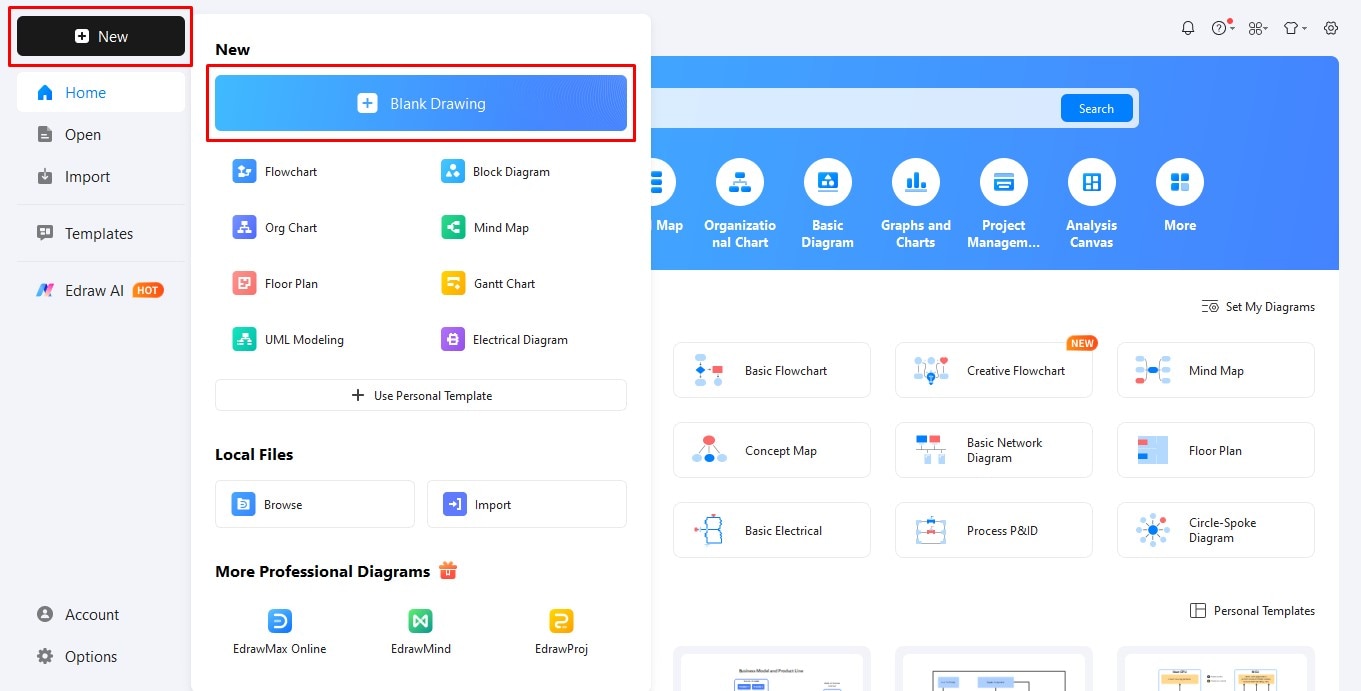
Step2Insert Background Image
- Click Insert on the top toolbar and select Picture from the options.
- Choose Local pictures and upload an image to use as the timeline’s background.
- You can customize the image’s brightness, contrast, transparency, and more. Simply click on the inserted image for the editing panel. Then select Adjust to tweak the background image.
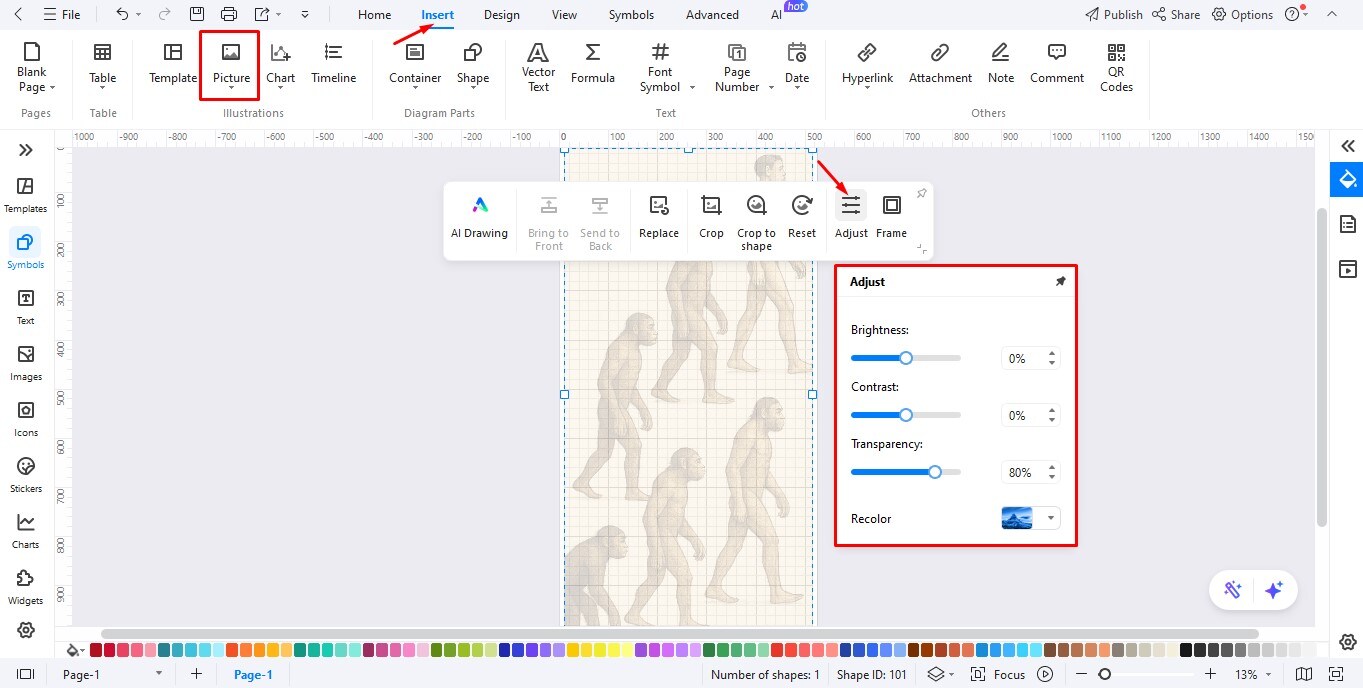
Step3Add a Heading to the Timeline
- You can add a heading to the timeline using either a text box or an inserted image. Let’s insert an image for this one.
- Follow the same steps outlined above: Insert > Picture > Local Pictures to insert the heading image.
- You can even add a symbol to complement the heading.
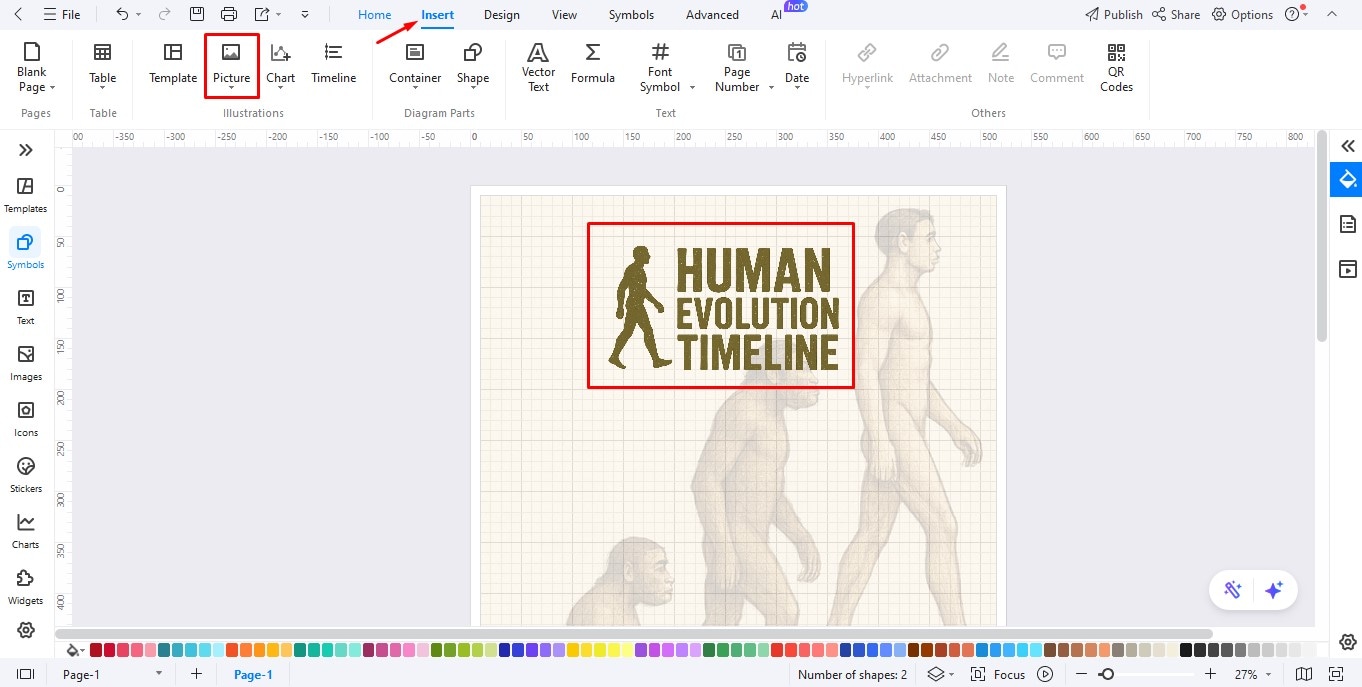
Step4Insert Vertical Timeline
- Locate and click Insert on the top toolbar.
- Select Timeline from the options and scroll down to Vertical Timeline.
- Choose the 4th timeline option that includes images and click OK.
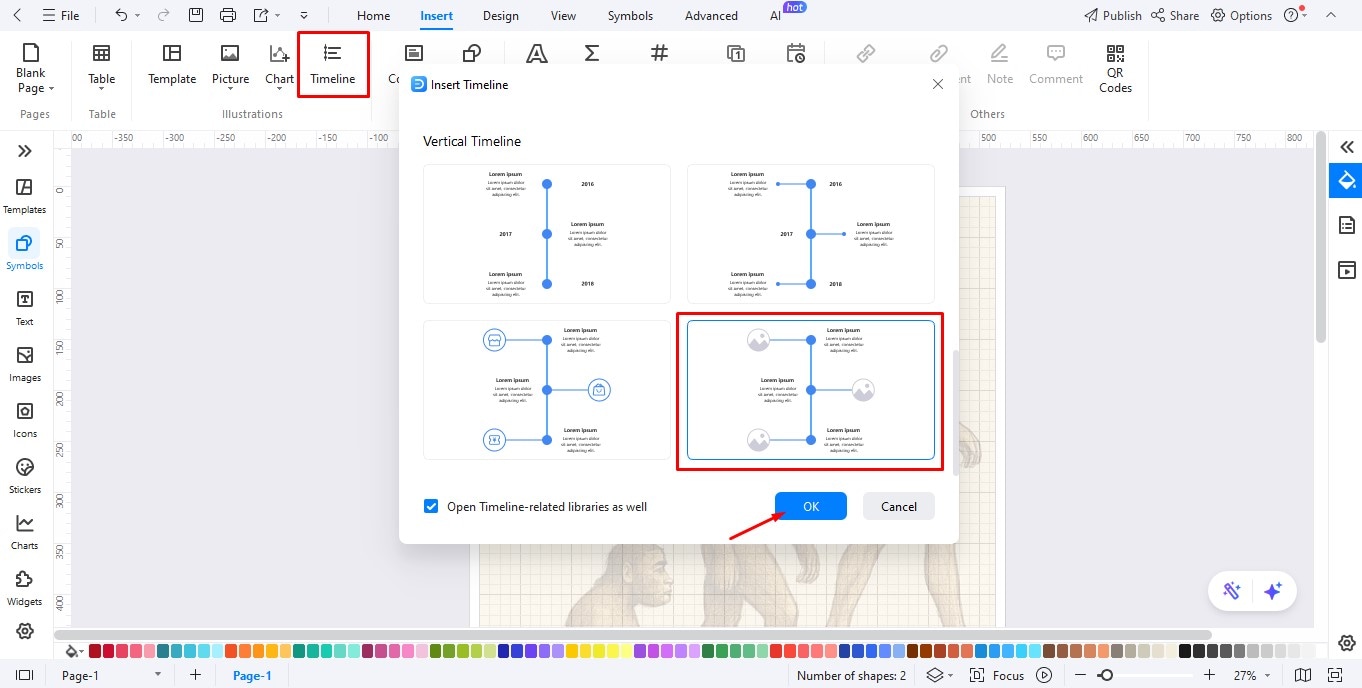
Step5Add Text to the Timeline
- Locate and click Text on the left editing panel.
- Select Click to Add Subtitle and insert the first date of the internet timeline.
- Next, select Click to Add Body and enter a key highlight of that date.
- Continue adding the remaining dates and events to the timeline.
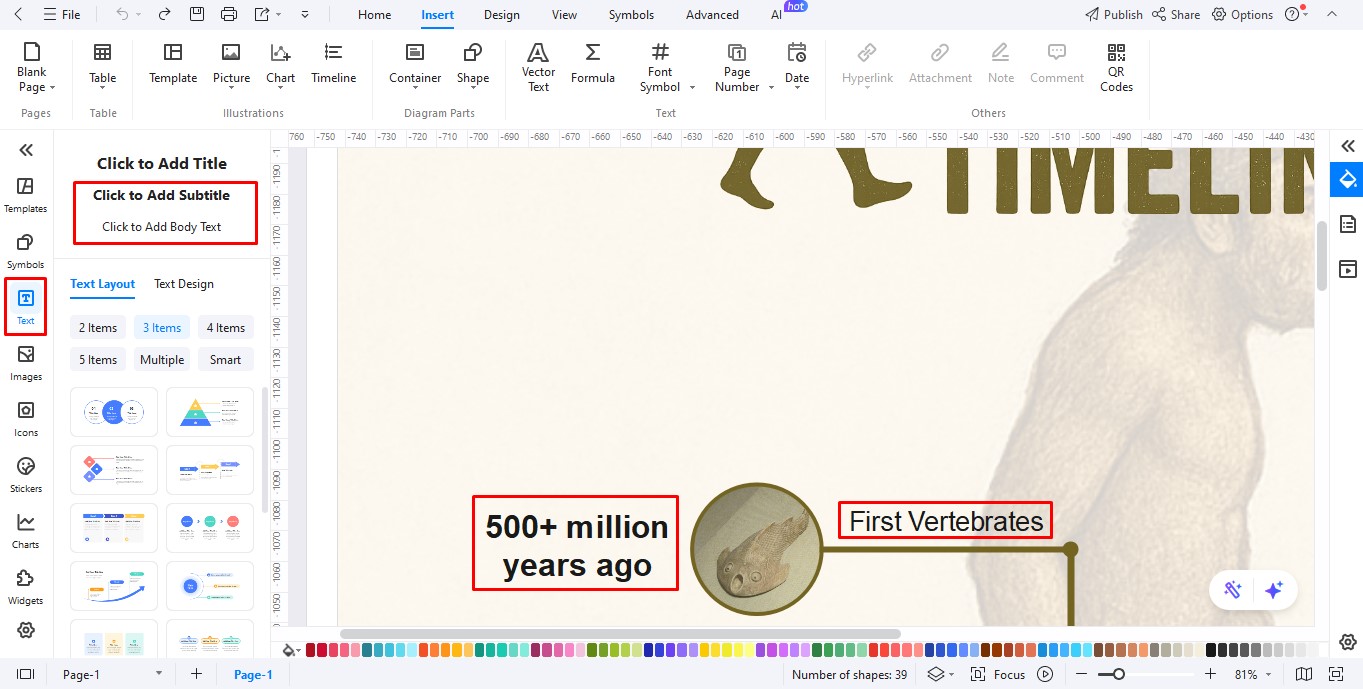
Step6Insert Thumbnail Images
- Visual cues can make your timeline more engaging so let’s start adding thumbnails. Follow Insert > Picture > Local pictures and add thumbnails to each highlight.
- If you want to edit the image’s shape, click on the thumbnail to reveal the customization panel. Select Crop to Shape and choose an outline that suits you.
- Follow the same steps to add the rest of the thumbnails.
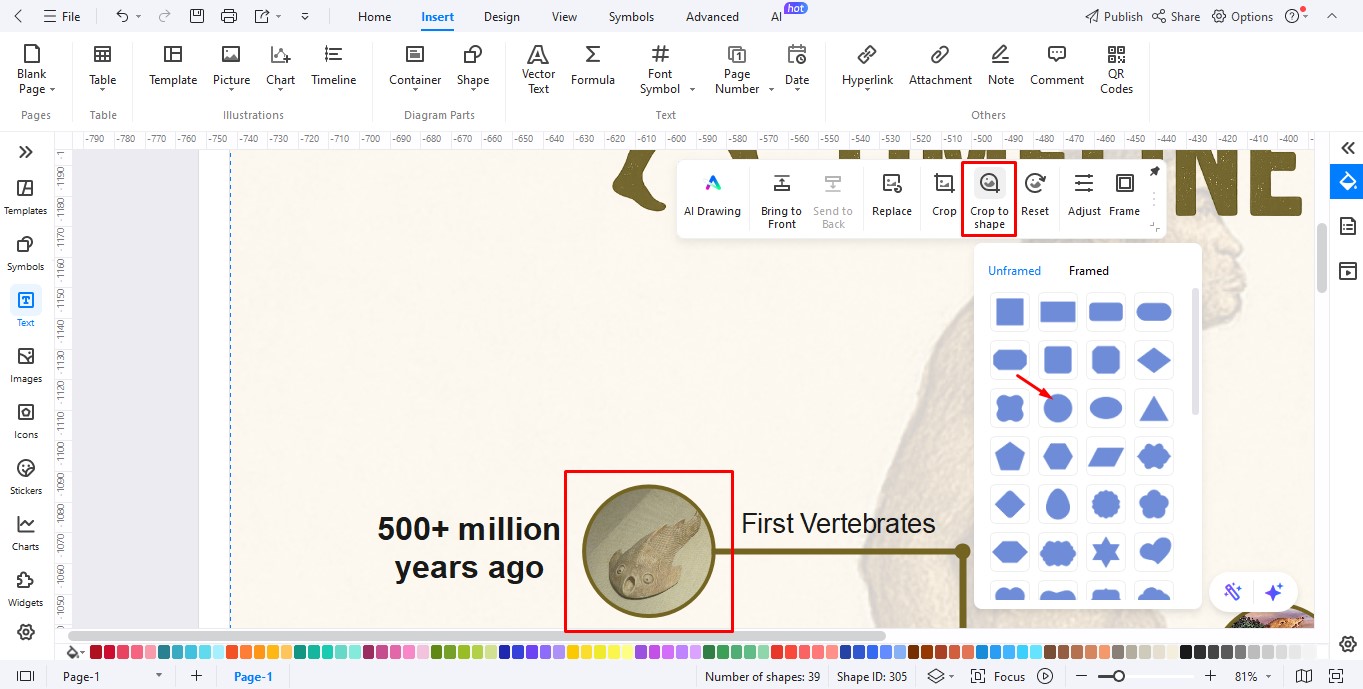
Step7Export File
- Continue adding events and thumbnails until the timeline is complete. When you’re done, click Export on the top panel to view your saving options.
- EdrawMax offers multiple saving options, including JPG, PDF, Word, Visio, GIF, etc.
- Select Graphics if you want to save the file in JPG format.
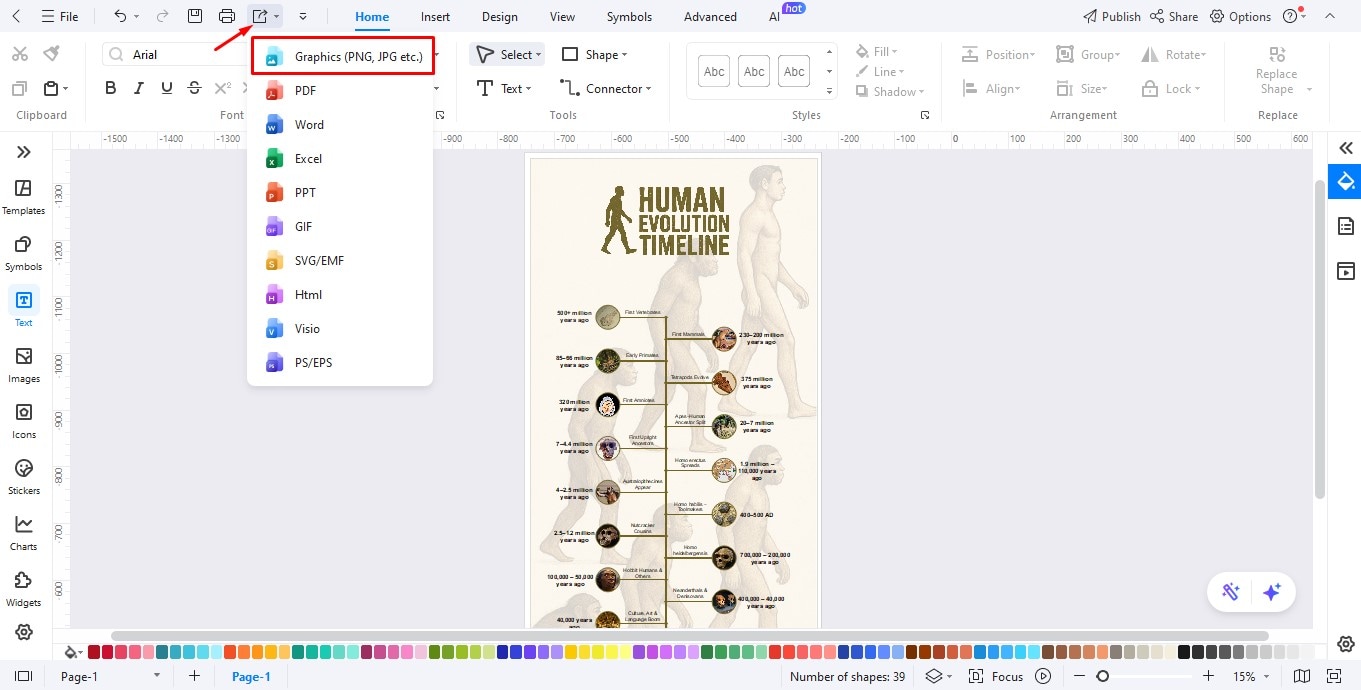
The Takeaway
Now that you know how the human evolution timeline began, isn’t it remarkable how far we’ve come? Dinosaurs ruled the Earth for 165 million years, yet in just a fraction of that time, humans have transformed from cave-dwellers into space explorers. Our journey has been nothing short of extraordinary.
And if you’d like to dive deeper into the evolution timeline, try EdrawMax, a modern testament to human creativity and genius.



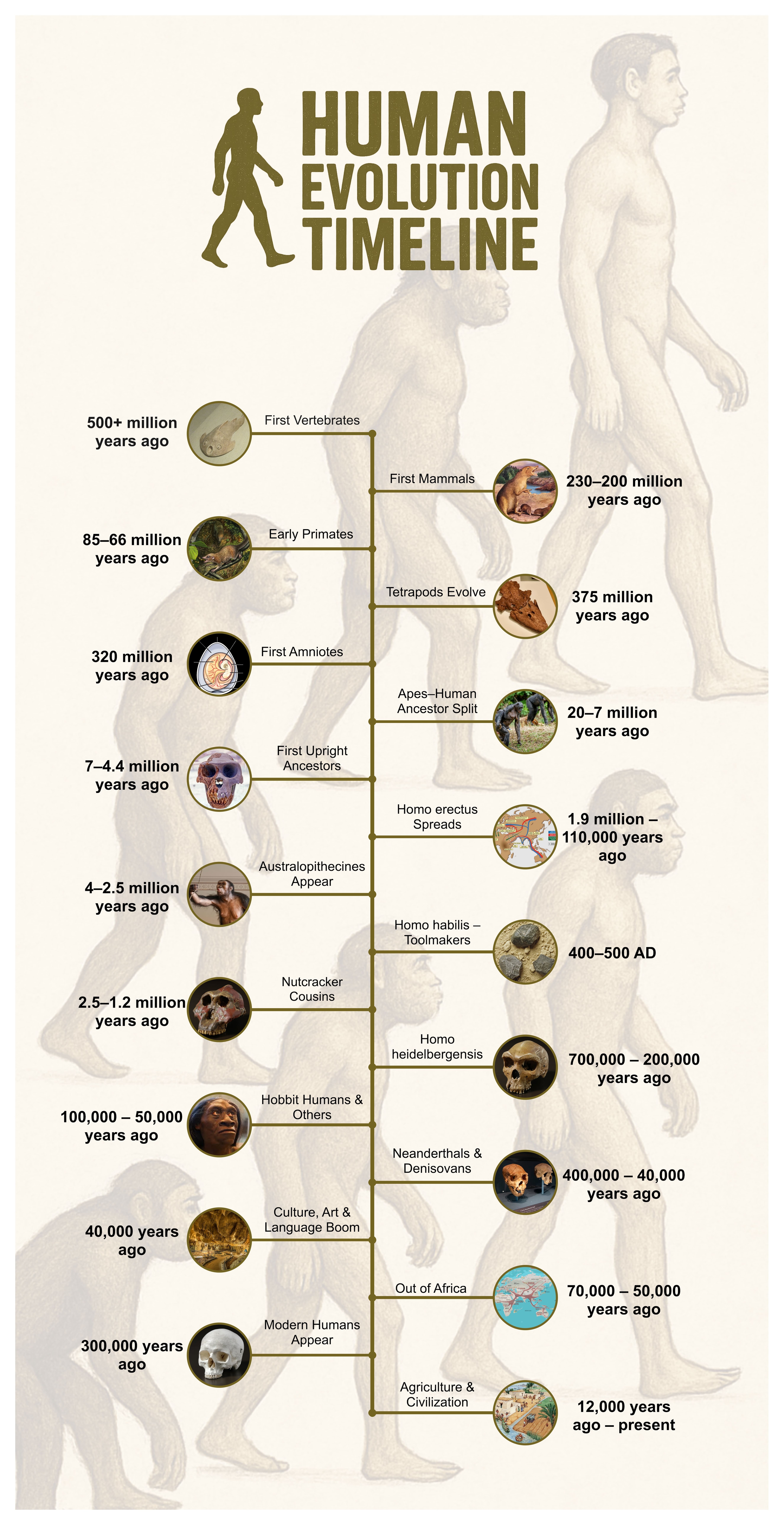
 below.
below.  below.
below. 